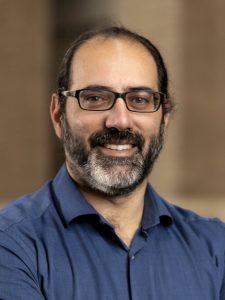Spotlight on Faculty – Soranno, Andrea
 Illuminating the Invisible: The Soranno Lab’s Study of APOE4 Conformations
Illuminating the Invisible: The Soranno Lab’s Study of APOE4 Conformations
Alzheimer’s disease is a ruthless, progressive neurodegenerative disease that induces memory loss and neuronal death in patients. With more than 3 million new cases each year in the United States alone, this disease likely plagues someone you know. Despite extensive research efforts, there is no cure for Alzheimer’s disease. However, using a new high-tech approach, the Soranno lab may have a new way to elucidate part of the disease from the inside out.
The major genetic risk factor for developing Alzheimer’s is a genetic variant in the gene apolipoprotein E (APOE) known as APOE4. This protein is normally involved in lipid metabolism and contributes to repairing neuronal damage in the brain. However, it is unclear how APOE4 predisposes individuals to develop Alzheimer’s.
The Soranno lab, led by Dr. Andrea Soranno, is taking a biochemical approach to understanding how the conformational properties of APOE4 may relate to its aberrant function and role in Alzheimer’s.
Soranno began his scientific career in Italy at the University of Milan. There, he first pursued a Master’s degree and subsequently a Ph.D. in Physics, where he got interested in the biophysics of disordered proteins. He then transitioned into the field of biochemistry with a postdoctoral position at the University of Zurich. During his postdoctoral fellowship, Soranno trained in the use of single-molecule fluorescence spectroscopy in the lab of prof. Ben Schuler, a leader in the field, where he strategically utilized these techniques to study disordered proteins.
“My postdoc was a wonderful adventure where I had the opportunity of applying my expertise as a physicist while I was learning more about biochemistry,” Soranno said. “I discovered that a lot of concepts of physics that has been developed for synthetic polymers can be applied to disordered proteins and these concepts help us to explain their conformations, dynamics, as well as the impact of the crowded cellular environment on them.”
In his own lab, Soranno continues to apply and develop single-molecule fluorescence techniques to study disordered proteins. Normally, proteins tend to arrange in well-defined structures that enable them to perform their function. However, intrinsically disordered proteins play a role in essential functions and disease even though they do not adapt such rigid structures, but conversely explores many different conformations. The techniques that Soranno has perfected throughout his career to study intrinsically disordered proteins are called single-molecule fluorescence resonance energy transfer (FRET) and fluorescence correlation spectroscopy (FCS) in which a single protein is labelled in known locations with two distinct fluorophores. Using an extremely sensitive confocal microscope, scientists in the Soranno lab can gain copious amounts of information about the protein of interest via the energy transfer between the fluorophores over time. Soranno describes this process as using an imaginary tape measurer that runs between the two fluorophores and enables discerning information about the conformation of the protein over time. Single molecule FRET has been used to study many phenomena such as the structure of nucleic acids, receptors, ligand binding, ion channel behavior, and more.
“I love that my background in single-molecule spectroscopy allows us to bring to light what we can’t see,” Soranno said.
Taking advantage of this technology, the lab is studying the conformations of APOE4 and hopes to identify a disordered conformation that leads to its aberrant activity. Leading the charge is Dr. Melissa Brereton, an instructor in the labs of both Dr. Soranno and Dr. Carl Frieden. For Brereton, using single-molecule FRET has revolutionized her study of APOE4.
“I presented my work at the Biochemistry and Molecular Biophysics Science Friday seminar and mentioned some of the challenges of learning more about the APOE4 structure,” Brereton explained. “Afterward, Andrea came up to me and said, ‘Hey, I think I have the perfect technique to move past some of the issues you are facing.’”
Using single-molecule FRET, the Soranno lab has started to unveil that APOE4 exists in multiple conformations. This has the potential to change the paradigm in the field due to the previous dearth in techniques to study the dynamic nature of proteins. From here, the Soranno lab is interested in investigating how the various conformations of APOE4 interact with other cellular components and determine the role of the protein in health and disease.
“In the future, we would like to move our testing into a more physiological environment, but I think having a strong foundation by using what we learn about ApoE molecular conformations is a really nice building block from which to work,” Brereton said.
It is clear that none of these studies would have been possible without strong collaborations between labs in and outside of the biochemistry department.
“[Washington University in St. Louis] is a very collaborative environment and this creates a lot of possibilities that otherwise would not be possible,” Soranno said.
Soranno has been instrumental in fostering a lab dynamic that encourages discovery and discussion.
“I love being able to have a conversation with someone who can challenge my ideas and help me see my project from a different perspective,” Brereton said. “I just think that helps us grow as scientists.”
The Soranno lab may be relatively new to the biochemistry department, but they are on their way to making large contributions to the field of biochemistry and neurodegenerative diseases.
“Looking at the world one molecule at a time reveals a complete new perspective to the problems”, Soranno said. “And when one changes perspective, there is always something new to learn and to discover.”
Written by Marissa Locke, 13 March 2020
Ms. Locke is a fourth-year graduate student in the Immunology program. She is completing her thesis work in the laboratory of Dr. Deborah Lenschow.
